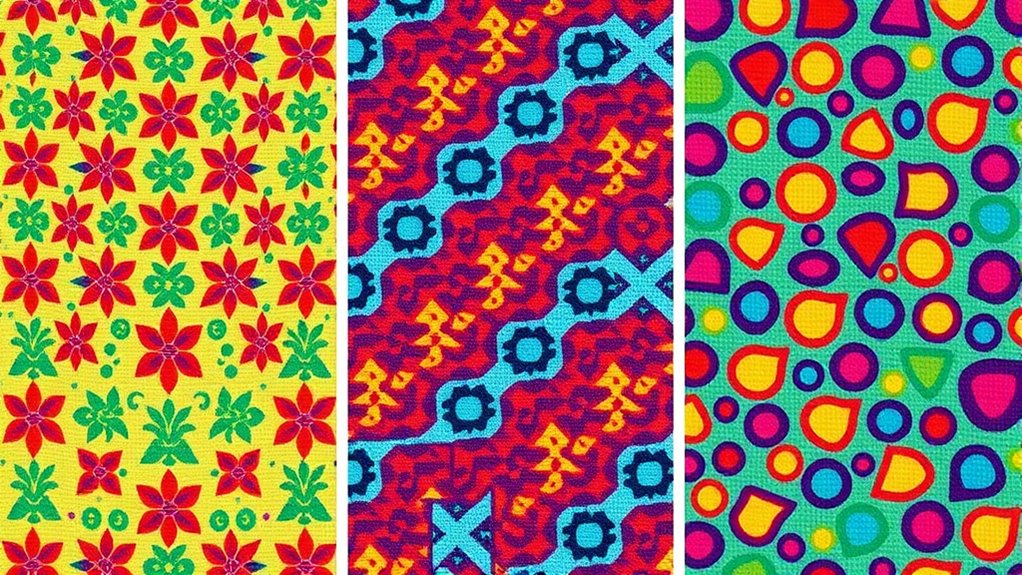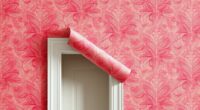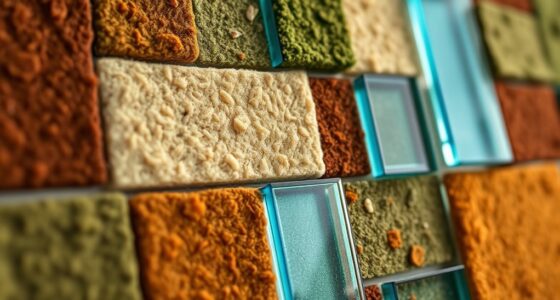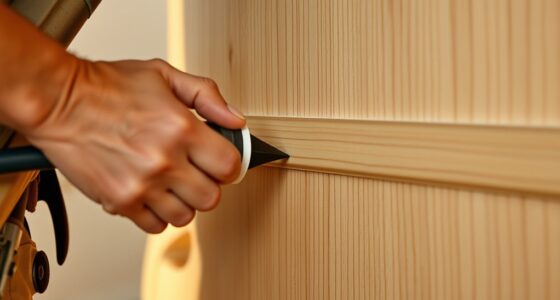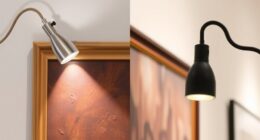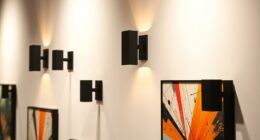Understanding pattern repeat and match types—straight, drop, and random—helps you create seamless fabric designs and perfect pattern alignment. Straight repeats align motifs in a grid, ideal for uniform, precise projects. Drop repeats add a staggered effect, hiding mismatches and adding visual interest. Random repeats offer organic, unpredictable variations for a lively look. Choosing the right type affects your pattern’s flow and style; exploring more reveals how each option can elevate your project.
Key Takeaways
- Understanding pattern repeat types (Straight, Drop, Random) helps in selecting the best for seamless design flow and aesthetic appeal.
- Recognizing match types (Straight, Drop, Random) ensures accurate fabric alignment and reduces pattern mismatches.
- Straight repeats are ideal for precise, symmetrical designs; Drop repeats add visual stagger; Random repeats offer organic variation.
- Match types influence fabric cutting, layout, and overall project cohesion, affecting final visual quality.
- Choosing the correct pattern match enhances efficiency, reduces waste, and achieves professional, polished results.
Understanding Straight Pattern Repeat
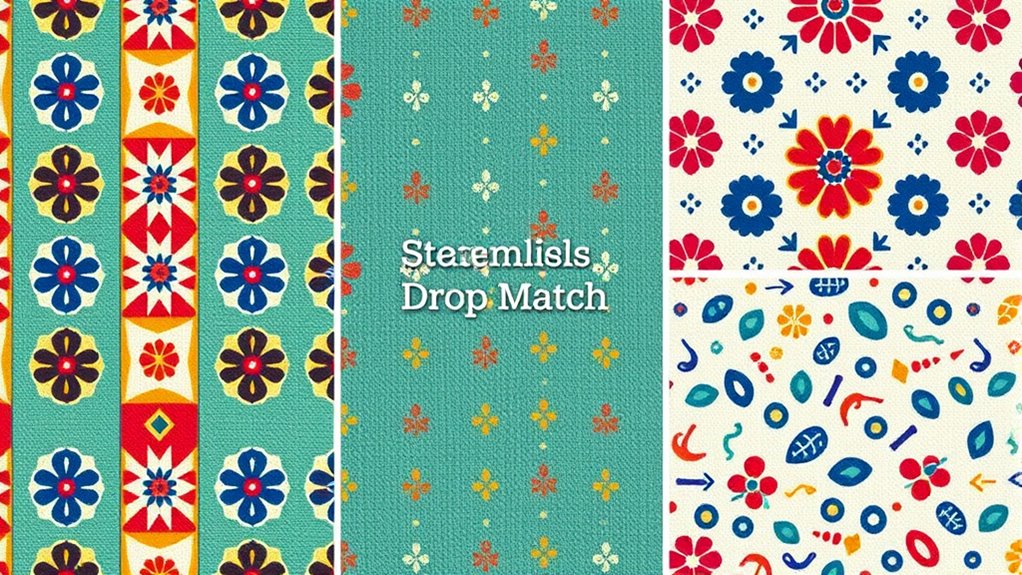
A straight pattern repeat is one of the simplest and most common types of pattern repeats used in textiles and design. With this method, the design lines up vertically or horizontally, creating a seamless flow across the fabric. Your fabric texture plays a key role, as a smooth or textured surface can influence how the pattern appears when repeated. When planning your project, consider color coordination; because the pattern repeats regularly, choosing complementary or harmonious colors ensures a balanced look. Straight repeats are easy to match at seams, making them ideal for large pieces or upholstery. By understanding how the pattern aligns and how the fabric’s texture interacts with the design, you can achieve a clean, professional finish in your textile work. Additionally, vibrational energy influences how patterns are perceived and can enhance the overall aesthetic of your design. Recognizing the material quality can also impact the durability and visual consistency of the pattern over time. Moreover, paying attention to fabric stretch is important, as it can affect how well the pattern aligns during sewing or application. Being aware of the print registration helps ensure the pattern remains consistent across multiple pieces or sections.
Characteristics of Drop Pattern Repeat
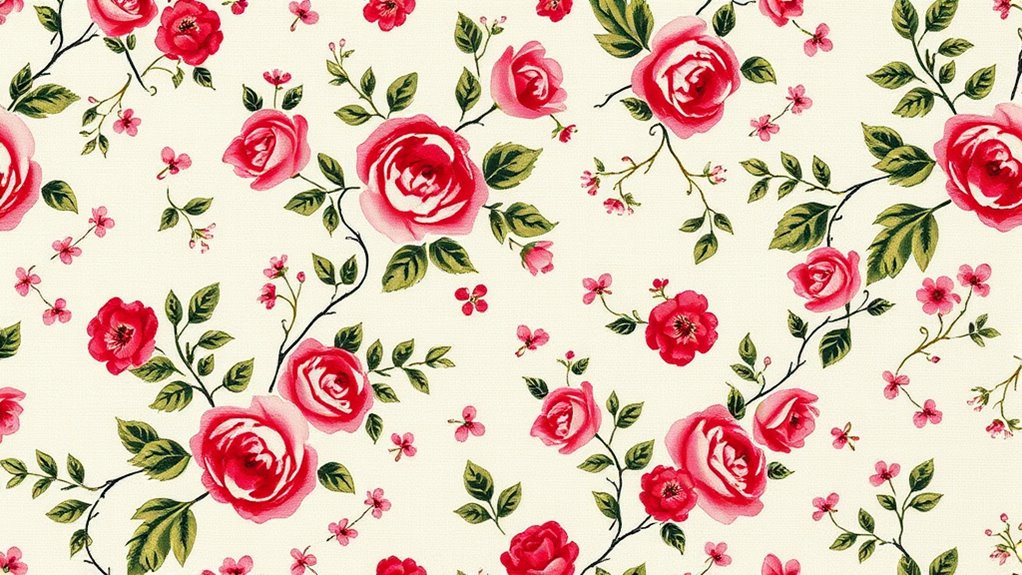
Drop pattern repeats create a more dynamic and visually interesting effect compared to straight repeats. This technique shifts the pattern so that the design drops below or above the baseline, adding depth to your fabric. It enhances fabric texture by creating subtle variations that catch the eye, making the material feel more intricate. When working with drop repeats, careful color coordination is essential—matching hues thoughtfully ensures the pattern flows seamlessly across the fabric. This type of repeat is ideal for designs aiming for a lively, less predictable look. It also allows for more flexibility in pattern alignment, which can hide seams or irregularities. Overall, drop pattern repeats lend your fabrics a sense of movement and complexity, making them stand out in any project. Additionally, considering the visual flow of colors and patterns helps create a cohesive and appealing design. Incorporating pattern harmony techniques can further enhance the seamlessness of the repeated design, ensuring a professional finish. Understanding the Gold IRA investment options can also inspire creative approaches to pattern design, emphasizing the importance of strategic planning in both fields. For example, using color theory principles can help achieve the desired aesthetic and balance in your fabric patterns.
Exploring Random Pattern Repeat

Exploring random pattern repeat lets you create unique pattern variations that break away from traditional symmetry. As you experiment, you’ll notice an unpredictable design flow that keeps viewers engaged. This approach adds a creative visual impact, making your work stand out with lively, unexpected elements.
Unique Pattern Variations
Have you ever noticed how random pattern repeats can create surprisingly unique variations? When you embrace this approach, you *discover* a rich diversity in design. The woven texture adds depth, making each pattern feel more tactile and authentic. By mixing a versatile color palette, you can craft patterns that seem spontaneous yet intentional. This randomness allows for unexpected combinations, giving your project a distinctive charm. Unlike straight or drop repeats, these variations are unpredictable, offering a sense of freshness. You can experiment with different textures and colors to produce one-of-a-kind looks that stand out. Embracing the uniqueness of random pattern repeats encourages creativity and results in designs that feel organic, lively, and truly original. Additionally, understanding design complexity can help you balance spontaneity with visual harmony. Incorporating visual rhythm can further enhance the coherence and appeal of your pattern variations. Recognizing the importance of personality expression can add a meaningful layer to your creative process, making each pattern not only unique but also reflective of individual style. Exploring clutter reduction techniques can also support a more focused and inspired design process, helping you create patterns that truly resonate.
Unpredictable Design Flow
Building on the idea of unique pattern variations, embracing an unpredictable design flow means intentionally allowing patterns to evolve spontaneously. This approach encourages you to experiment with random pattern repeats, creating a sense of organic movement. In textile manufacturing, this method can result in lively, dynamic fabrics that captivate the eye. By applying color theory thoughtfully, you enhance the visual impact of unpredictable designs, blending hues to achieve harmony or contrast. The key is to trust the flow and let patterns develop naturally, avoiding rigid structures. Incorporating quality control measures ensures consistency and safety in the final product. Additionally, embracing flexibility in your design process enables greater creative expression and adaptation to spontaneous changes. Understanding cybersecurity vulnerabilities can help protect your digital design files from cyber threats. When working with farmhouse-inspired textiles, incorporating natural materials can further enhance the authenticity and charm of the final product. This unpredictable style adds a layer of excitement and uniqueness to your textiles, making each piece distinctive. When you embrace this approach, you harness the power of randomness to craft engaging, vibrant designs that stand out.
Creative Visual Impact
Random pattern repeats create a dynamic visual impact that instantly captures attention. They infuse your design with energy and spontaneity, making it stand out. To enhance this effect, consider how color harmony plays a role—using contrasting or complementary shades can heighten visual interest. Texture balance is equally important; mixing smooth and rough surfaces adds depth and richness. When you opt for a random repeat, you break predictable patterns, encouraging viewers to explore every detail. Think about:
- Using bold, unexpected color combinations
- Balancing textured elements to prevent chaos
- Creating focal points with contrasting hues
- Maintaining harmony despite the randomness
- Incorporating asset division strategies to elevate your design approach
Additionally, understanding pattern matching techniques can help you achieve a more cohesive look while maintaining the spontaneity of the random repeat.
How to Identify Different Match Types
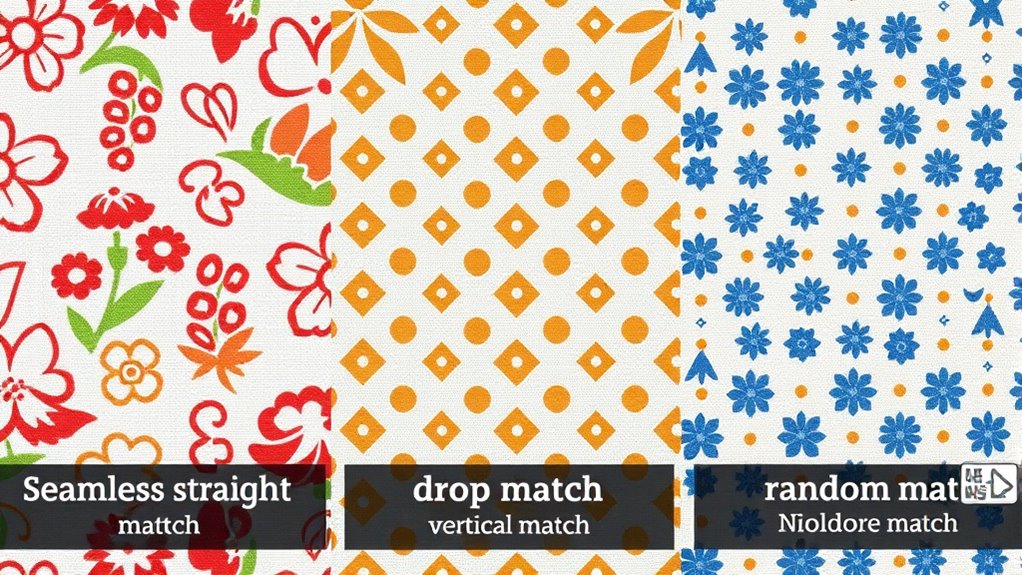
Understanding different match types is essential for accurately interpreting pattern repeats in textiles. To identify them, examine how the pattern aligns at the seams. For straight matches, the pattern edges meet seamlessly along vertical or horizontal lines, showing clear pattern symmetry. Drop matches involve shifting the pattern so the design continues at a different point, often creating a staggered effect. Random matches don’t follow a specific alignment, making seams less noticeable. When evaluating fabric dyeing, look for consistent color placements that highlight pattern symmetry. This consistency helps distinguish straight matches from other types. Recognizing these differences allows you to select the right pattern for your project, ensuring a cohesive look and reducing fabric waste. Additionally, understanding pattern construction can enhance your ability to choose fabrics that will match more effectively. Considering heat pump noise levels ensures that your fabric choices and installation locations do not interfere with quiet operation. Being aware of color placement can further improve your matching accuracy and overall project outcome. Moreover, understanding headphone compatibility can be useful when designing workspaces that require noise-canceling or audio features, ensuring comfort and functionality. Clear identification improves your overall understanding of how patterns are constructed and matched.
Advantages of Using Straight Match Patterns
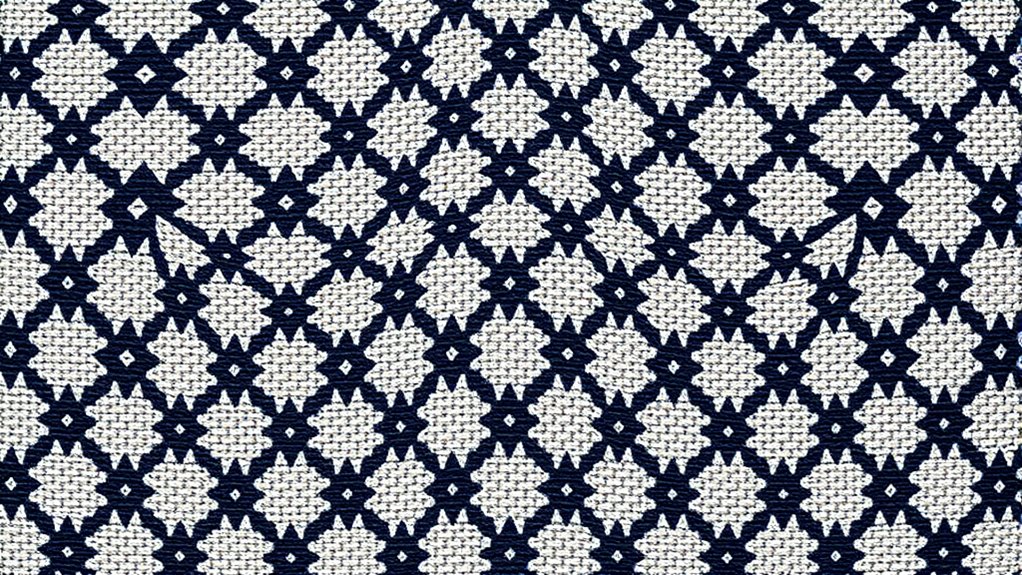
Using straight match patterns offers several advantages that can streamline your sewing process and enhance the final appearance of your project. This pattern match type simplifies fabric alignment, reducing errors and saving time. It’s especially helpful when working with fabric pattern terminology that emphasizes symmetry and consistency. Straight match patterns also support precise textile design techniques, ensuring your design flows seamlessly across seams. Additionally, they make pattern matching more predictable, which benefits complex garments or projects with large fabric pieces. You’ll find that these patterns are easier to layout and cut, leading to a cleaner, more professional look. Overall, straight match patterns provide a reliable foundation for achieving polished results with less frustration and higher accuracy.
Benefits of Drop Match Patterning
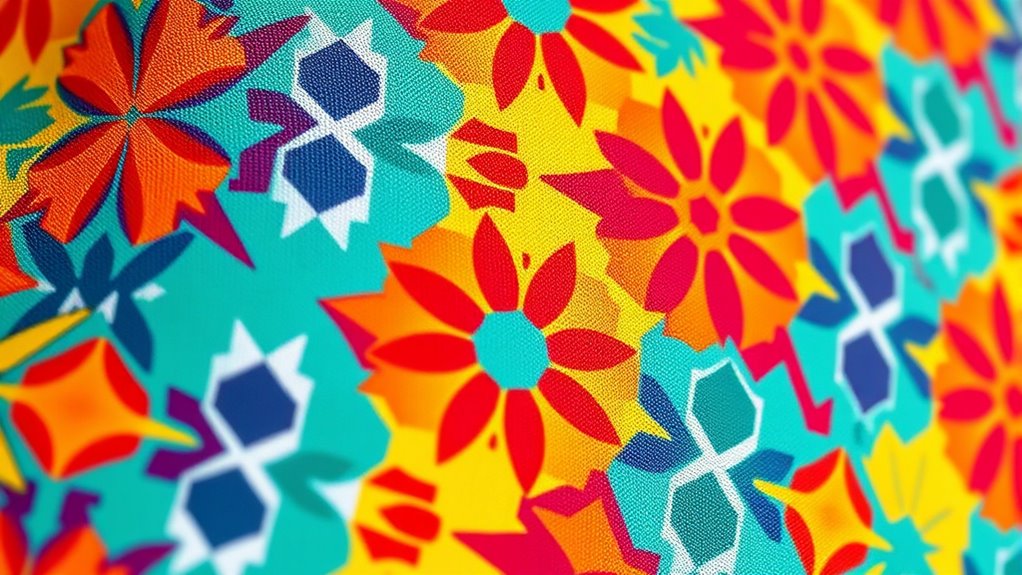
Drop match patterning adds visual interest to your designs by creating a more dynamic look. It offers flexible options to align patterns creatively, giving you more design freedom. Plus, it helps you use fabric efficiently, reducing waste and saving costs.
Enhanced Visual Interest
Have you ever noticed how drop match patterning adds a dynamic, eye-catching element to fabric designs? It creates a sense of movement and visual interest that keeps your eyes engaged. This pattern style allows for more playful and varied arrangements, making your project stand out. When considering drop match, focus on color coordination—choosing hues that complement each other enhances the overall effect. Fabric selection also matters; lightweight or textured fabrics can amplify the pattern’s impact. Drop match offers a sense of rhythm and flow, making your design lively and less predictable. It’s perfect for adding depth without overwhelming the design. Ultimately, this pattern type brings a fresh, vibrant look that elevates your fabric choices and makes the finished piece truly enthralling.
Flexible Design Options
One of the key benefits of drop match patterning is its flexibility, allowing you to explore a variety of design options with ease. Drop matching lets you create dynamic layouts that enhance fabric texture and color coordination without overwhelming the design. You can mix patterns or vary color placements for visual interest. This approach reduces waste and simplifies alignment, giving you more control over the finished look. Here’s a quick overview:
| Pattern Type | Fabric Texture Impact | Design Flexibility |
|---|---|---|
| Straight | Uniform, smooth | Limited |
| Drop | Varied, layered | High |
| Random | Uneven, textured | Very high |
| Repeat | Consistent | Moderate |
This table highlights how drop match offers creative freedom while maintaining cohesive fabric textures and color harmony.
Efficient Fabric Usage
Utilizing drop match patterning can substantially improve fabric efficiency by reducing waste during the cutting process. This technique minimizes fabric manipulation and leverages pattern symmetry to align repeats seamlessly. Drop matching allows you to cut multiple pattern pieces with fewer fabric scraps, maximizing material use. It’s especially effective with large repeats, where precise pattern placement decreases the need for extra fabric. By thoughtfully planning the layout, you can achieve a consistent, professional look while conserving fabric. Drop match patterns also make handling fabric easier, reducing the risk of misalignment. Overall, this approach helps you save costs, cut down on waste, and streamline production, making it a smart choice for efficient fabric usage.
- Less fabric waste
- Faster cutting process
- Better pattern alignment
- Cost savings
When to Choose a Random Match Approach
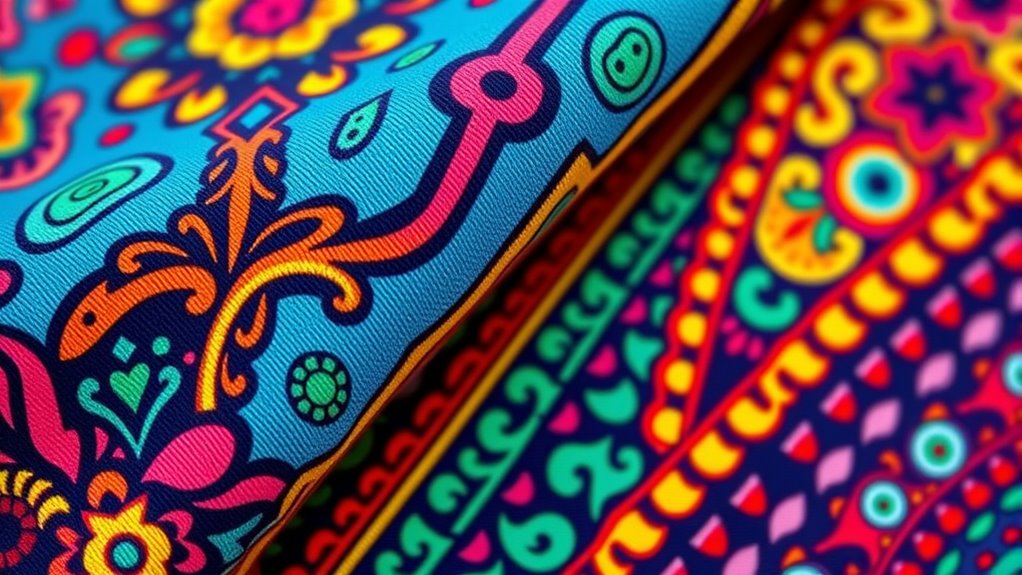
Choosing a random match approach makes sense when you need to introduce variability or avoid predictable patterns. In textile manufacturing, this method helps create unique, dynamic designs that stand out. It’s especially useful when you want to achieve a natural, organic look that mimics randomness found in nature. Additionally, if your project demands flexible color coordination, a random match prevents the eye from following strict lines or repetitions, making the design feel more lively and spontaneous. This approach is ideal for fabrics meant for casual or artistic apparel, home decor, or accessories where unpredictability adds visual interest. Use the random match when consistency isn’t your priority, and you aim to produce a fabric with a more relaxed, eclectic aesthetic.
Tips for Seamless Pattern Alignment
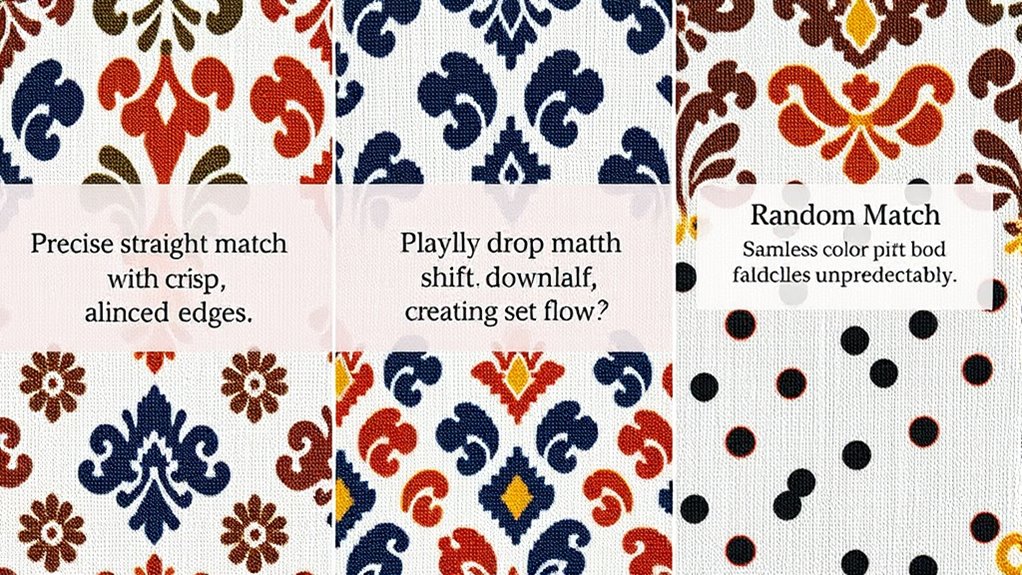
Achieving seamless pattern alignment requires careful planning and attention to detail during the design and production process. To guarantee a smooth match, focus on consistent color coordination, so hues flow naturally across seams. Pay close attention to fabric texture, as rough or uneven surfaces can disrupt alignment. When prepping your pattern, mark key points and use guides to keep everything aligned during cutting and sewing.
Seamless pattern alignment needs careful planning, consistent colors, fabric texture, and precise markings for perfect matching.
- Match pattern elements at seams before sewing for perfect continuity
- Use fabric with similar texture to prevent shifting or misalignment
- Keep color coordination consistent across all pieces to avoid mismatched lines
- Double-check pattern repeats, especially on complex designs, before cutting
These tips help create a polished, cohesive look with seamless pattern alignment.
Practical Applications of Each Repeat and Match Type

Understanding the practical applications of each repeat and match type helps you select the right technique for your project. Straight repeats suit projects emphasizing pattern symmetry, creating a balanced look ideal for wallpaper or upholstery. Drop repeats work well when you want a seamless flow, especially with complex patterns requiring precise color coordination. Random repeats add variety, perfect for organic designs or when you aim to hide pattern mismatches. Use the table below to guide your choice:
| Pattern Type | Best For | Key Benefit |
|---|---|---|
| Straight | Symmetrical designs | Precise alignment for consistency |
| Drop | Large motifs | Seamless flow, hides mismatches |
| Random | Organic, abstract designs | Creative variation, flexibility |
Selecting the right match type enhances pattern cohesion and visual harmony in your projects.
Frequently Asked Questions
How Do Pattern Repeats Impact Fabric Durability and Wear Over Time?
Pattern repeats can influence fabric durability and wear over time by affecting wear resistance and fabric longevity. When patterns align properly, they distribute stress evenly, reducing weak points that lead to tearing or fraying. Misaligned repeats may cause uneven wear, especially in high-stress areas. By choosing the right pattern repeat match type, you can enhance both the longevity and resilience of your fabric, ensuring it holds up better with regular use.
Can Different Match Types Be Combined Within a Single Design?
Sure, you can combine different match types within a single design—irony at its finest, right? It’s all about pattern alignment and motif variation, creating visual interest rather than chaos. By skillfully blending straight, drop, or random match types, you guarantee a cohesive look while adding variety. Just remember, the key is precise pattern alignment; otherwise, your design might look more mismatched than intentional.
What Tools or Techniques Assist in Accurately Matching Pattern Repeats?
You can use digital patterning tools and computerized matching techniques to guarantee accurate pattern repeat matching. These tools help you align and replicate repeats precisely, saving time and reducing errors. Software like Adobe Illustrator or specialized textile design programs offer features to automatically match and tile patterns seamlessly. By utilizing digital patterning, you get consistent results, especially when working with complex or multiple match types within a single design.
How Do Pattern Repeats Influence the Cost of Production?
Pattern repeats directly impact your fabric cost and printing complexity. When repeats are intricate or large, they require more fabric and detailed printing, increasing expenses. Straight repeats are usually simpler and cost less, while drop and random repeats can add complexity, raising production costs. By understanding your pattern repeat type, you can better estimate costs and choose designs that balance visual appeal with budget constraints.
Are There Industry Standards for Pattern Repeat Measurements?
You wonder if industry standards exist for pattern repeat measurements, and the answer is yes, but they vary. Precise pattern alignment is essential, and repeat measurement guidelines ensure consistency across projects. Typically, standards recommend specific repeat lengths based on fabric type and design, but always check with your supplier or industry guidelines. Staying within these standards helps you achieve quality and uniformity, elevating your work to a professional level.
Conclusion
As you weave your patterns, envision each repeat as a thread guiding your design’s flow. Straight repeats lay a steady path, drop patterns add surprise, and random repeats create a lively tapestry. By mastering these match types, you’ll craft seamless, vibrant textiles that dance with harmony or spontaneity. Embrace each approach like a painter blending colors—your skill transforms simple repeats into enthralling, textured art that invites the eye to explore endlessly.
